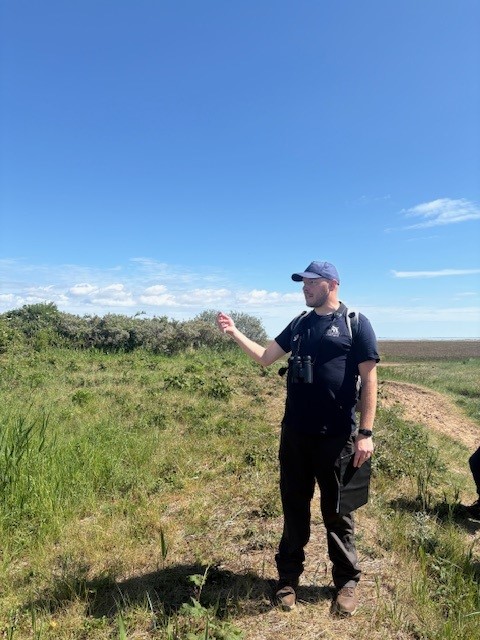- Get ready with the FREE Big Butterfly Count app or by downloading Butterfly Conservation’s FREE butterfly ID chart
- Join in between July 18 and August 10
- Add your counts via the website or app
Families invited to join the Big Butterfly Count
Everything you need to know about the 140th Lincolnshire Show
New employment park planned for Scunthorpe growth corridor
A 77-acre business park is set to be developed near junction 3 of the M180 as part of the Lincolnshire Lakes strategic growth zone. The project, named Forge Point, is being led by property developer Hargreaves Land and will form part of a wider mixed-use development that includes thousands of new homes and community infrastructure.
Forge Point is positioned to accommodate up to 959,300 square feet of new commercial space and is expected to offer both freehold and leasehold design-and-build options. It sits adjacent to land earmarked for 550 homes, forming part of a larger 6,000-home target across the Lincolnshire Lakes scheme.
The business park aligns with the area’s Area Action Plan, which supports the integration of high-tech business units, offices, and hospitality facilities to drive long-term economic development.
The site’s proximity to major transport links and a growing residential base is expected to appeal to logistics, advanced manufacturing, and professional services firms seeking scalable space in the North Lincolnshire region.
Cleethorpes walks reveal nature’s quiet power
Cleethorpes’ saltmarsh is gaining attention not just for its beauty, but for its critical role in climate defence. In the spring, this overlooked stretch of coastline sequesters carbon in its mud, mitigates tidal surges, and provides sanctuary to wildlife. Now, with the help of a new Coastal Ranger, efforts are underway to help more locals and visitors appreciate what’s quietly thriving at their feet.
Funded by the Heritage Lottery Fund, the newly appointed Coastal Ranger, Josh Forrester, is leading guided walks through the Cleethorpes Nature Reserve. Beginning behind the Leisure Centre, the route showcases a rare mix of sand dunes, scrubland, and saltmarsh, habitats that support everything from Southern Marsh Orchids to migratory birds by the tens of thousands.
This stretch of coastline, which extends into the 30 km-long Lincolnshire Coronation Coast National Nature Reserve, is protected under several international conservation agreements due to its unique biodiversity. Yet, it’s just steps away from Cleethorpes’ bustling tourist spots — a contrast that brings both opportunity and risk.
Josh’s walks are designed to spark curiosity and caution. He explains how Sea Buckthorn stabilises dunes with its roots, and why even the seemingly harmless cobwebs of Brown-Tail Moths deserve respect. He also highlights how accidental disruption, like paddleboarding through salt marsh or letting dogs roam off path, can damage fragile ecosystems.
The events, timed with National Nature Reserves Week, are part of a longer-term effort to reduce recreational disturbance and increase local awareness. With no barriers separating the wild from the well-trodden, Josh believes that understanding is the best protection.
Image source: North East Lincolnshire Council
Young talent eyes steel future in Scunthorpe
More than 200 people have applied for just 30 apprenticeship places at British Steel’s Scunthorpe site, as the company prepares to welcome its first new cohort in three years.
The roles include 24 engineering craft apprenticeships and six technical apprenticeships, forming part of a wider recruitment push that includes 180 additional permanent jobs across various departments.
Successful applicants will enter a three-year training programme that blends technical learning with hands-on experience, delivered in partnership with local training providers. The goal is to prepare them for long-term careers in the business.
The application window for the apprenticeships closes at 11.59 pm on Friday, 6 June 2025.
This wave of interest in British Steel’s apprenticeship programme signals a renewed enthusiasm for skilled trades and industry-backed career pathways, especially in regions with a strong industrial heritage, such as Scunthorpe.
Alongside the apprenticeships, British Steel has open vacancies in various fields, including engineering, safety, chemistry, cleaning, and legal support, offering a diverse range of entry points for those looking to be part of the company’s evolution.
Image credit: Stock.adobe.com/riachsionWatering plants the right way this June matters more than ever
With hotter days settling in and a warmer-than-average British summer on the cards, gardeners are being urged to rethink how—and when—they water their plants.
Warmer temperatures may make it feel natural to reach for the hose more often, but timing is everything. Experts recommend watering early in the morning or late in the evening to minimise moisture loss due to midday evaporation. Watering during the heat of the day not only wastes water but can also leave plants thirsty and stressed.
Signs that plants aren’t coping include drooping leaves, browning edges, and fewer blooms or fruits. In severe cases, overwatering in response to these symptoms can worsen the situation, leading to root rot, yellowing leaves, and fungal infections.
Gardeners are advised to target the base of the plant, directing water where it’s most needed, at the roots. Plants in containers, pots, or hanging baskets are especially vulnerable in the heat and should be prioritised, as they rely entirely on your watering routine to stay healthy.
Rising temperatures also accelerate weed growth, creating additional competition for soil nutrients. Quick removal is key. Weeds are easier to pull when they are freshly sprouted and can be repurposed as compost, giving something back to the garden.
Image credit: Stock.adobe.com/gpointstudioThe Baston Car & Bike Show parks up at Grimsthorpe Castle
Toe-tapping jazz afternoons come to Burghley this weekend
British strawberries set to be sweeter and arrive earlier this summer
British strawberries are expected to be sweeter, juicier, and more flavourful this summer, with the first harvests arriving on shelves earlier than usual. A combination of unusually sunny spring weather and increased bee activity during the flowering period has created ideal growing conditions for this year’s crop.
The warm days and cooler nights earlier in the year, part of a weather pattern that saw some of the highest sunshine levels recorded in a century, have contributed to higher natural sugar levels and better-shaped fruit. According to British Berry Growers, who represent the majority of UK berry producers, these conditions have not only improved the flavour but also brought the season forward by about a week.
The early and strong start to the strawberry season is also a positive sign for growers. Consistent yields and high-quality fruit are enabling farms to meet demand, manage operations efficiently, and foster long-term sustainability.
With the season underway, British strawberries are set to become a summer highlight, perfect for garden gatherings, desserts, or simply enjoyed on their own.
Image credit: Stock.adobe.com/Tim URBaby banks report rising demand as working families feel pressure
A growing number of families in Lincolnshire are relying on baby banks for essential supplies as the cost-of-living crisis continues to mount. Local services in areas such as Market Rasen, Horncastle, and Grimsby are experiencing higher demand, with some anticipating a further increase during the summer school holidays.
According to the Baby Bank Alliance’s latest survey, 220,000 families across the UK accessed baby banks in 2024, up from 163,000 in 2023. Over 3.5 million items such as nappies, clothing, and cots were distributed last year, a 143% year-on-year rise.
The Market Rasen Baby Bank, which launched less than two years ago, reported that usage has quadrupled in just six months, with 76 families now regularly using the service across the town and surrounding villages.
The data reflect a broader trend of financial strain among working households, where both parents are often employed but still struggle to meet their monthly expenses. Rising nursery fees, up 10% on average following recent changes to employer taxation, have added to the burden, as reported by the National Day Nurseries Association.
Local businesses are helping fill the gap with donations, but organisers warn that the financial stress facing families is unlikely to ease anytime soon.
Image credit: Stock.adobe.com/Анастасія Стягайло











